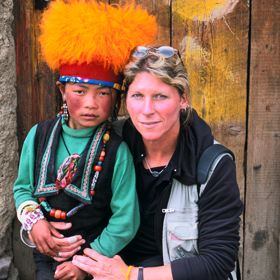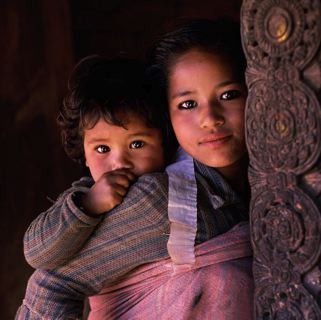 When a bus Alison Wright was traveling on in a mountainous road in Laos was ripped apart, her life was ripped apart as well.
When a bus Alison Wright was traveling on in a mountainous road in Laos was ripped apart, her life was ripped apart as well.
Before the accident, Alison had been a well-known and much lauded photojournalist.
After the accident, she was just a woman trying to hang on— to her life, to her career, to the way things had been.
Prior to the accident, Alison had dodged bullets, riot police and hostile governments in her quest to document the human condition. But she also enjoyed a life of freedom and movement that had her hiking, kayaking, wind surfing, and scuba diving with ease.
Read the previous entries in this series: The Wright Way to Travel, Part 1 as well as The Wright Way to Travel, Part 2.
After the accident, something as simple as putting one foot in front of the other often proved a challenge. But Alison is focused and fiercely determined. Nothing was going to stop her from a full recovery. After more than 20 surgeries, years of physical therapy and a steady diet of Eastern as well as Western medical and meditative practices, Alison triumphed.
To celebrate her body’s rebirth, she climbed Mount Kilimanjaro.
 But the accident had shattered more than her bones. Alison was also struggling with the crippling effects of post-traumatic stress disorder. “Insomnia was taking over my life,” she says. “When I did sleep I was tortured by violent dreams filled with lacerated bodies, screeching metal and, for some reason, drownings.”
But the accident had shattered more than her bones. Alison was also struggling with the crippling effects of post-traumatic stress disorder. “Insomnia was taking over my life,” she says. “When I did sleep I was tortured by violent dreams filled with lacerated bodies, screeching metal and, for some reason, drownings.”
Acknowledging that “the physical healing had taken so much work that the emotional healing took a back seat,” Alison knew it was time to face down her fears. But how? Fate served up the answer.
In 2003, Alison was sent to Thailand on assignment. While there, she decided to pay a visit to the Thai hospital where she had been painstakingly cared for after the accident. Her emotional healing began the day she was able to thank the doctor who saved her life.
Next she headed to the Kasi Clinic in Laos where she had been taken immediately after the accident. “It was every bit as run-down as I remembered,” recalls Alison. “A tiny ramshackle shed in a cow pasture.” There were still no beds, hardly any medicines and few trained staff. But Alison got to give a hug to Khamthat Chanthamougkhong, the young man who had sewed up her arm and kept her from bleeding to death. Another part of her healing fell into place.
Then she climbed onto the bus headed to Luang Prabang to relive the original journey. The mountainous curves and precipitous drops were still brain numbing and heart stopping. Even more amazing, as the bus rounded a curve, Alison looked up to see another bus hurtling toward them. Again, screeching brakes. Screaming people. And Alison left to think, “Not again.”
But this time, the buses clipped one another, then continued on without incident. Alison had lived through her worst fear. “This remedy is not for everyone,” says Alison, “but it worked for me.” After that ride her nightmares were gone and her flashbacks began to recede. But Alison knew she had more work to do. Now it was time to give back.
 As a photojournalist, Alison’s first thought was to give back through her work. This she did with her Faces of Hope book and calendars, which, along with proceeds from her other books and calendars (including the autobiographical Learning to Breathe), helps the Faces of Hope Fund work with community organizations and non-governmental agencies to provide health care and education in Asia and Afghanistan.
As a photojournalist, Alison’s first thought was to give back through her work. This she did with her Faces of Hope book and calendars, which, along with proceeds from her other books and calendars (including the autobiographical Learning to Breathe), helps the Faces of Hope Fund work with community organizations and non-governmental agencies to provide health care and education in Asia and Afghanistan.
But with every passing day, Alison became more committed to helping the people who had helped her the day of the accident. After raising $10,000, this past November, Alison returned to the Kasi clinic in Laos. With her were five California-based doctors from the non-profit group Doctor to Doctor. Setting up shop in the tiny clinic, they were able to deliver both medical advice and a van’s worth of medical supplies to the ecstatic staff.
With that important milestone reached, Alison set a new goal: to raise $12,000 more to buy the clinic an X-ray machine so the staff and their patients can avoid the five-hour drive to the nearest hospital. Typical of Alison, she has hope. And determination.
“I always see the glass as half-full,” she says. “And I’m someone who does what I say I’m going to do.” So get ready Kasi clinic. Alison should be heading your way soon, equipped with a new X-ray machine.
But don’t expect her to be coming by bus. She’s been there, done that. Doesn’t want to go that way again. But she will get there. Because this is one fierce woman, living life to the fullest, one life-sustaining breath at a time.
By Jamie Simons for PeterGreenberg.com. For more information on the Faces of Hope Fund, visit www.facesofhope.org or www.Alisonwright.com.
Check out photojournalist Alison Wright’s slideshows on PeterGreenberg.com:
Read more inspiring stories from the Grateful Traveler series:












